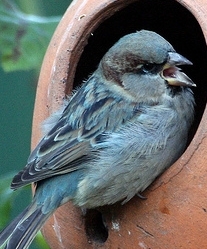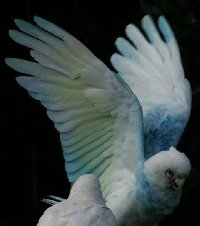Blue House Sparrow of Oz {New Update/More Photos}
Posted by: Loren Coleman on July 2nd, 2009
No one is claiming they are blue birds of happiness, but there is a compelling mystery here.
A blue house sparrow (Passer domesticus) has appeared in Sydney, Australia, out of nowhere. Experts are convinced the color is genuine, but baffled as to the cause.
This happened last April, but Where Light Meets Dark is bringing this up on July 2nd, 2009, because they have received a report – including photographs – of other blue birds, probably of different species, in New South Wales, Australia.
For more details, see here and here.

Update: There are new details and more photos.
First, a reader sent me word of another blue sparrow. See here.
Also, Where Light Meets Dark has been sent more info and new photos too. See here.


Thanks to Chris.
About Loren Coleman
Loren Coleman is one of the world’s leading cryptozoologists, some say “the” leading living cryptozoologist. Certainly, he is acknowledged as the current living American researcher and writer who has most popularized cryptozoology in the late 20th and early 21st centuries.
Starting his fieldwork and investigations in 1960, after traveling and trekking extensively in pursuit of cryptozoological mysteries, Coleman began writing to share his experiences in 1969. An honorary member of Ivan T. Sanderson’s Society for the Investigation of the Unexplained in the 1970s, Coleman has been bestowed with similar honorary memberships of the North Idaho College Cryptozoology Club in 1983, and in subsequent years, that of the British Columbia Scientific Cryptozoology Club, CryptoSafari International, and other international organizations. He was also a Life Member and Benefactor of the International Society of Cryptozoology (now-defunct).
Loren Coleman’s daily blog, as a member of the Cryptomundo Team, served as an ongoing avenue of communication for the ever-growing body of cryptozoo news from 2005 through 2013. He returned as an infrequent contributor beginning Halloween week of 2015.
Coleman is the founder in 2003, and current director of the International Cryptozoology Museum in Portland, Maine.












Hi Loren,
I can confirm the photos I received are definitely another species and there are multiple birds involved.
I wonder what readers think might be causing this unusual colouration?
Chris.
Very odd. Blues in birds are typically structural colors; they are not derived from pigments.
My initial thought was that the bird simply bathed in a color dyed pond or other body of water.
I can’t imagine a food source turning the bird blue. Whereas flamingos get their pink color from beta carotene by eating shrimp, I don’t see a food source turning the sparrow blue.
I did come across some scientific articles about the nanostructure of bird feathers and colorizing. Very technical articles, but solid scientific evidence. This bird possibly have a genetic mutation affecting the structure of the feathers. Key word = possibly.
We have good photographic evidence, now let’s get a feather for some good scientific evidence and have it analyzed.
Alton,
If blue in bird feathers is generally derived from structural features, instead of pigmentation, could an albino individual exhibit a blueish tint (i.e. lack of other color pigments + blue structural coloration = pale blue sparrow?)
Hmmm… This is interesting, and reminds me, randomly enough, of Paul McCartney & Wings.
See update.
Nice new pictures… is this happening just in Australia?
RESPONDING TO planettom responds:
July 2nd, 2009 at 11:26 am
…I can’t imagine a food source turning the bird blue. Whereas flamingos get their pink color from beta carotene by eating shrimp, I don’t see a food source turning the sparrow blue.
WHAT ABOUT BLUE CHEESE?
Interesting find—and beautiful to behold. Cute fellers.
For what is worth, there are also reports of a Purple Squirrel seen living in a church in England. One can Google the information about it. Folks are saying this may also be a “pigment job.” Could this also be a “Previously undiscovered species?.” 🙂
Don’t want to sound like a know it all but Flamingos get their pink colour from blue-green algae when feeding.
Actually, Paul, Kuroneko was right – it comes from the shrimp they eat, not the algae they don’t.
I’m afraid you’ll find that a majority of the flamingos’ colouration comes from the algae and only partly from the shrimp who also eat the algae. Some zoos, years ago, only feed shrimp to their flamingos and they stayed white. It wasn’t until they introduced the algae to their diet that they became pink.
Jeremy,
Per your question: I don’t think so. Blue feathers, when mussed up, take on a kind of greyish appearance.
Oh, well I just learned something new today… and the Discovery Channel lied to me.
This blue House Sparrow is particularly cool because it really looks like the blue feathers are BLUE – structurally blue, not just dyed blue. They have the right look, like Bluebird or Blue-gray Gnatcatcher feathers. They seem to be growing in patterns that I have seen before with the white feathers of partial albino birds.
The Little Corellas (the white cockatoos in the next photos) look more like they have rubbed up against some kind of dye, or may even have been painted. I remember a few years ago in my area there were reports and photos of pink, orange, and yellow seagulls. These birds turned out to have been spray-painted by bored teenagers! Sometimes researchers mark white birds with dye, though they usually just put a spot on the back or breast. I know people in the US sometimes dye chicks and ducklings for Easter… do people do that with cockatoos in Australia???
I remember on the comedy quiz show 8 out of 10 cats they showed a clip from the 80’s of a gentleman who lived in the Carribbean and loved the colourful birds and when he returned to Britain he decided his white doves at his large house were to plain so he employed a young man to dye them, blue, red, green and yellow. As stated above it with a explain the cockaoo as their domesticated but not the wild birds.
I know companies dye/tatoo fish to make patterns. Furthermore, some fish are injected with anemone DNA to make vibrant colours like the GloFish.
However, if the birds are dyed, the colour will disapear after the birds molt. If they stay blue, than t has to be some sort of genetics. Maybe there is a recessive gene that makes the feathers blue? Or maybe they are artifically genetically altered?
why is this considered unusual? I see lots of blue birds out here. Probably due to a change in diet or enviorment, forced evolution/mutation if you will. Try putting blue gelatin in your garden sometime, interesting results.
my thoughts are either cross breeding, a disease or fungus, or a new speicies
Maybe these birds are the rare blue crabs of sparrows.
I found some interesting reads about carotenoids, astaxanthin and crustacyanin. Just Google those terms if you are interested in learning more.